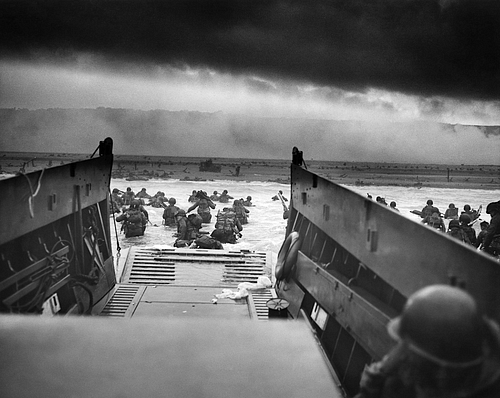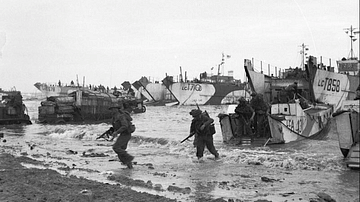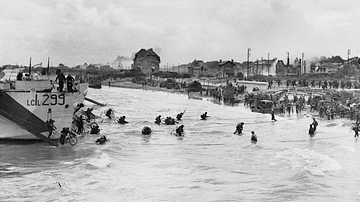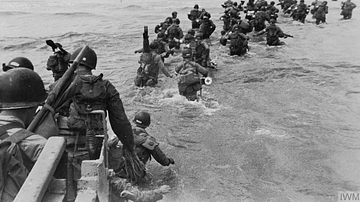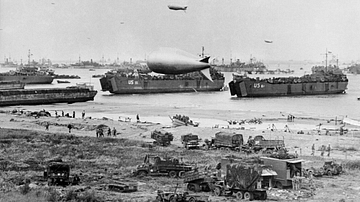
Omaha Beach was one of two beaches attacked by the US armed forces on D-Day, 6 June 1944. Strong German defences on the bluff overlooking the beach made this area the most difficult of the Normandy landings, but by the end of the day, the beachhead was secure, albeit with more casualties than at any other D-Day beach.
Operation Overlord
The amphibious assault on the Normandy beaches was the first stage of Operation Overlord, which sought to free Western Europe from occupation by Nazi Germany. The supreme commander of the Allied invasion force was General Dwight D. Eisenhower (1890-1969). The commander-in-chief of the Normandy land forces, 39 divisions in all, was the experienced General Bernard Montgomery (1887-1976). Commanding the air element was Air Chief Marshal Trafford Leigh Mallory (1892-1944), with the naval element commanded by Admiral Bertram Ramsay (1883-1945).
Nazi Germany had long prepared for an Allied invasion, but the German high command was unsure where exactly such an invasion would take place. Allied diversionary strategies added to the uncertainty, but the most likely places remained either the Pas de Calais, the closest point to British shores, or Normandy with its wide flat beaches. The Nazi leader Adolf Hitler (1889-1945) attempted to fortify the entire coast from Spain to the Netherlands with a series of bunkers, pillboxes, artillery batteries, and troops, but this Atlantic Wall, as he called it, was far from complete in June 1944. In addition, the wall was thin since there was no real depth to the defences.
Field Marshal Gerd von Rundstedt (1875-1953), commander-in-chief of the German army in the West, believed it would be impossible to stop an invasion on the coast and so it would be better to hold the bulk of the defensive forces as a mobile reserve to counterattack against enemy beachheads.

Field Marshal Erwin Rommel (1891-1944), commander of Army Group B, disagreed and considered it essential to halt any invasion on the beaches themselves. Further, Rommel believed that Allied air superiority meant that movements of reserves would be severely hampered. Hitler agreed with Rommel, and so the defenders were strung out wherever the fortifications were at their weakest. Rommel improved the static defences and added obstacles to all the larger beaches. In the end, Rundstedt was given a mobile reserve, but the compromise weakened both plans of defence. The German response would not be helped either by their confused command structure, which meant that Rundstedt could not call on any armour (but Rommel, who reported directly to Hitler, could), and neither commander had any control over the paltry naval and air forces available or the separately controlled coastal batteries. Nevertheless, the defences were bulked up around the weaker defences of Normandy to an impressive 31 infantry divisions plus 10 armoured divisions and 7 reserve infantry divisions. The German army had another 13 divisions in other areas of France.
Operation Neptune
Preparation for Overlord occurred right through April and May of 1944 when the Royal Air Force (RAF) and the United States Air Force (USAAF) relentlessly bombed communications and transportation systems in France as well as coastal defences, airfields, industrial targets, and military installations. Over 200,000 missions were conducted to weaken as much as possible the Nazi defences ready for the infantry about to be involved in the largest troop movement in history. The French Resistance also played their part in preparing the way by blowing up train lines and communication systems that would ensure the German armed forces could not effectively respond to the invasion.
The Allied fleet of 7,000 vessels of all kinds departed from English south-coast ports in an operation code-named Neptune. The ships gathered off Portsmouth in a zone called 'Piccadilly Circus' after the busy London road junction, and then made their way to Normandy. At the same time, gliders and planes flew to the Cherbourg peninsula in the west and Ouistreham on the eastern edge of the planned landing. US paratroopers attacked in the west to try and cut off Cherbourg. At the eastern extremity of the operation, British paratroopers aimed to secure the bridges and eastern flank of the invasion.
The amphibious attack was set for dawn on 5 June, daylight being a requirement for the necessary air and naval support. Bad weather led to a postponement of 24 hours. Shortly after midnight, the first waves of 23,000 paratroopers landed in France. From 3:00 a.m., air and naval bombardment of Normandy began, letting up just 15 minutes before the first troops landed on the beaches. The invasion area was divided into five code-named beaches. While US troops attacked Utah Beach and Omaha Beach to the west, Canadian troops landed at Juno Beach, and British troops launched an assault on Gold Beach and, at the landing's eastern end, Sword Beach.
Omaha: The Defences
Omaha Beach, which was just 4 miles (6.4 km) long, stretched from Port-en-Bessin to Vierville-sur-Mer. The beach was divided into eight operational sectors. To the west of Omaha Beach was a gun emplacement above the cliffs of Pointe du Hoc, a target given to the US 2 and 5 Ranger Battalions. As it turned out, this encasement, which would have been a major threat to the landings, had had its guns removed (they were subsequently found in the nearby forest and destroyed). What Omaha did have was a 100-foot (30.5 m) high bluff, which meant the German gun positions could pepper any part of the crescent-shaped shore the moment troops left their landing craft. There were only five narrow gullies leading off the beach, and the defenders could concentrate their fire down these gullies. The cliff was protected at its base by rolls of barbed wire, mines, and hidden boobytrap explosives. The shallows of Omaha Beach had sandbars, which impeded the landing craft. The beaches were also protected by three rows of obstacles, some of them submerged, and all of them with lethal mines or shells attached. Another distinct advantage for the defenders was the presence of an additional division, which had just happened to have been stationed there for a training exercise; two regiments of this veteran division became directly involved in the defence of Omaha.
German firepower at Omaha was formidable. Strongpoints along the cliff, each manned by around 30 troops, had ten machine guns, one 50-mm cannon, and an artillery piece. In addition, Omaha had:
Eight concrete bunkers containing heavy 88mm or 75mm guns, sixty light artillery guns, thirty-five small artillery pieces in pill boxes and eighteen anti-tank guns. One central strongpoint also had automatic flame throwers. Between the strongpoints there were infantry trenches with at least eighty-five machine-guns. To the rear there were forty pits housing rocket launchers and mortar positions.
(Cawthorne, 168)
Faced with all this firepower, the US troops had only one thing in their favour, and a small saving grace at that. The entrenched defenders relied on ammunition resupply by truck, and this would become impossible thanks to the Allied air and naval bombardment. Taking the beach, then, would be a battle of attrition.
Landing on Omaha
Establishing a beachhead at Omaha was the task given to the battle-experienced 1st US Infantry Division, nicknamed the Big Red One because of their shoulder patch of that colour. They were commanded by General Clarence R. Huebner. Also involved were troops of the US 29th Infantry Division and British personnel as crews of the landing craft and obstacle-removal teams. The first waves of troops landing on the other beaches usually met with heavy casualties, but these eased as the defensive gun positions were made inactive and subsequent waves could push on under much lighter enemy fire. Omaha was to be an entirely different story.
The naval fleet designated to Omaha, which included the US battleships Texas and Nevada, began bombarding the coast at 5:50 a.m. At 6:00 a.m. bombers attacked the defences but did little damage due to poor visibility and inaccurate bombing. The naval bombardment ceased at 6:25 a.m., and the landing craft took over, firing rockets, which all fell short.
Right from the off, the US troops suffered from the heavy seas that made their landing extra difficult. In each of the 48 assault vessels of the first wave, the 32 men, when not being seasick into them, were obliged to use their helmets to frantically bail water. The seemingly interminable journey from the ship to the beach took an exhausting two or three hours.
27 tanks were immediately lost when released too far from shore. Almost all of the first wave of artillery pieces were lost in the same way. The handful of tanks that did make it in the first wave were destroyed on the beach by German anti-tank guns. 13 of the 16 Allied bulldozers – meant to rip down the mined obstacles that protected the beach – were lost. Several landing craft were blown up by the submerged mines. Strong winds and the tide meant many troops were landed up to a mile from their planned target area. With officers killed and communications equipment destroyed, organising the assault on the defensive positions became extremely difficult. It seemed that if anything could go wrong for the attackers at Omaha, it did go wrong.
By the time the infantry reached the beach, they were desperate to get on dry land again, but the moment the landing craft doors were lowered a deadly fire cut down the huddle of men inside since the German machine-gunners had already been getting their range by firing at the door when it was still closed. Chief Electrician's Mate Alfred Sears remembers:
We hit the sandbar, dropped the ramp, and then all hell poured loose on us. The soldiers in the boat received a hail of machine-gun bullets. The Army lieutenant was immediately killed, shot through the head. (Ambrose, 32)
Men tried to avoid the bullets by climbing over the side, but all too often their equipment weighed them down, and they drowned. For those able to get out, hundreds were immediately cut down in the shallows, their bodies to be then mown down by the next landing craft coming in. Many of those who made it to the beach did so only because they had abandoned their kit, in some cases, even their weapons. Sergeant Harry Bare describes his landing:
I tried to get my men off the boat and make it somehow to get under the seawall. We waded to the sand and threw ourselves down and the men were frozen, unable to move. My radioman had his head blown off three yards from me. The beach was covered with bodies, men with no legs, no arms – God it was awful…I tried to get the men organized. There were only six out of my boat alive.
(Ambrose, 331)

The defenders were able to set up a withering crossfire against the attackers who could not move off the beach. Machine gun, mortar, and sniper fire rained down on the beach. The loss of most of the tanks meant that the men on the beach had very little cover except anti-tank obstacles. Helping a fallen comrade in most cases proved fatal. Dashing to a shale bank at the end of the beach, the men could go neither forward nor back. At 7:00 a.m., the second wave of landing craft arrived, but they faced the same withering fire as the first wave. Landing craft were still being sunk by mortars and mines. On top of that, the tide was coming in, and so the troops that had made it onto land were forced to move forward without any cover. The casualty rate amongst the attackers was as high as 60%.
Sub Lieutenant Jimmy Green, commanding the first wave of landing craft that morning, gives the following account:
When I left A Company on this ridge, some three hundred yards away from the Germans, the tide was lapping at their feet. They couldn't stay there long, the tide was coming in – it comes in at a rate of knots on that beach, it really does flood in. They had to move and, as they went up the beach, the Germans with their machine guns opened fire and wiped them out. Practically all of A Company, the first wave, were wiped out. There were very few survivors by the time the second wave came in. All of the people I landed from my boat were killed including the captain, Taylor-Fellers. Practically all of A Company had perished within minutes of walking up the beach. They had no cover, no craters to get into, and as they walked up the beach they were just sitting targets, well standing targets, and down they went, mowed down by machine guns. They didn't have a chance. It's lived with me ever since. I can still see those fresh-faced boys getting out of the boat…It does haunt me. I still see their faces.
(Bailey, 275)
Very slowly, small groups crawled up the beach to attack the gun positions using their rifles, machine guns, grenades, mortars, and Bangalore torpedos. Some tanks that had made it were supported by shells fired from the ships off the beach as they took on the pillboxes, gradually wearing down the German resistance. The beach was slowly being cleared of obstacles as new waves of landing craft came in, but the men on the beach could not make progress further inland, and the landings were temporarily halted. Whatever the cost, the bluff had to be stormed. As Colonel George Taylor told his men: "Two kinds of people are staying on this beach, the dead and those who are going to die. Now let's get the hell out of here" (Cawthorne, 179).
The defenders had no reserves since the local commander wrongly thought these were needed elsewhere, and, in any case, they became involved with the US paratroopers behind the main lines. By 9:00 a.m., there were 5,000 US troops on the beach. Sheer numbers, the use of Bangalore torpedos to blast new routes off the beach, and heroic determination meant the tide began to turn. The defensive positions could now be attacked from the side and rear and gradually the defence was neutralised. US reserves were sent in at 10:45 a.m. By noon, four exits from the beach had been established. To General Omar N. Bradley (1st US Army Commander) offshore, who did not receive beach updates because of equipment failures, it seemed Omaha was a total disaster. A withdrawal was contemplated, but, actually, things were better than they looked, especially as heavy artillery began to be landed from 4:00 p.m. By nightfall, the US Army had won control of the beach.
On D-Day, almost 34,000 troops were landed at Omaha, with 2,200 casualties, although no official figures exist for D-Day alone, and estimates vary. The casualties were about 1 in 18, but in those first waves, it had been more like a 50:50 chance of survival. The battle had established a beachhead that was just 2,500 yards (2,300 m) deep. It had been a momentous day, as Charles Sullivan, who landed three craft at Omaha, notes:
In twenty-eight years of service, three wars, fourteen overseas tours of duty, thousands of faces, only Normandy and D-Day remain vivid, as if it happened only yesterday. What we did was important and worthwhile.
(Ambrose, 367)
The next day, the troops from Omaha linked with the British Army at Gold Beach. More troops and materials were landed at Omaha in the following weeks, aided by the establishment of a floating Mulberry Harbour off the beach.

The Battle for Normandy
By the end of D-day, 135,000 men were landed across the entire front, and relatively few casualties were sustained – some 5,000 men – far fewer than the generals had expected. The defenders eventually organised themselves into counterattacks, deploying their reserves and pulling in troops from other parts of France. This is when French resistance and Allied aerial bombing became crucial, seriously hampering the German efforts to reinforce the coastal areas of Normandy. Most of the German generals wanted to withdraw, regroup, and then reattack in force, but, on 11 June, Hitler ordered there be no retreat. Operation Neptune officially ended on 30 June. Around 850,000 men, 148,800 vehicles, and 570,000 tons of stores and equipment had been landed since D-Day.
The next phase of Overlord was to push the German army out of Normandy, but this proved more difficult than anticipated with the defenders fighting resolutely and aided by the broken bocage countryside of fields and hedgerows. There were some serious Allied setbacks such as the staunch defence of Caen and very heavy fighting around Avranches. It was not until August that General George Patton and the US Third Army were punching south at the western side of the offensive. The major Brittany ports were taken, and the Allies swept southwards to the Loire River from St Nazaire to Orléans. On 15 August, a major landing took place on the southern coast of France, the French Riviera Landings. On 25 August, Paris was liberated. The northern and southern Allied armies linked up in September and pushed the German army back towards Germany as the conflict reached its final phase.


